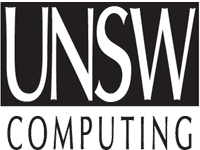|
|||||||||||||||||||||||||||||||||||||||||
| Bioinformatics - 3647 | |||||||||||||||||||||||||||||||||||||||||

Whilst jointly administered by the Schools of Computer Science and Engineering and the Faculty of Science, for convenience, day to day administration of the program is conducted through the Computer Science and Engineering Student Office, to which enquiries should be directed.
Bioinformatics is an emerging discipline at the convergence of computing and the life sciences aimed at development of technologies for storing, extracting, organising, analysing, interpreting and utilising the 'tsunami' of information being generated. It is truly an interdisciplinary field. Not only have advances in computing helped accelerate the process of data generation, but the need to process and analyse this vast amount of information has led to advances in both software technologies (databases, algorithm design, machine learning and visualisation) and hardware architectures (IBM's investment in the development of petaflop computers is directly motivated by Bioinformatics problems). Additionally, there is considerable interest in Bioinformatics from researchers in medicine and mathematics. Bioinformatics graduates receive a Bachelor of Engineering after four years. The program is multi-disciplinary and students will achieve a high level of expertise across computing, maths and biology. Students will undertake major project in the fourth year bringing these areas together. Note: The School also offers the combined degrees:
BE (Bioinformatics)/BA program 3703, BE (Bioinformatics)/BSc program 3755 and the concurrent degree: BE(Bioinformatics)/MBiomedE program 3757 Program Objectives and Learning Outcomes Please contact the School of Computer Science and Engineering for information on the Program Objectives and Learning Outcomes.
Year 1
And ONE of:
And ONE of:
And ONE of:
And ONE of:
Year 2
And TWO of:
And ONE of:
Year 3
Year 4
Electives
For details regarding elective choices, please consult the CSE website at: http://www.cse.unsw.edu.au/information/current-students/undergraduate/programs/bioinformatics/BINFA13647.html
Any BIOC/BIOT/MICR/BABS3xxx course for which prerequisites have been completed can be selected as a 3rd year life science elective. Recommended electives include: Any COMP2xxx or level 3/4/9 COMP course for which prerequisites have been completed can be selected as a computing elective. The computing elective can also be replaced by one of the following Mathematics and Statistics course:
General Education Requirements UNSW wants all students to develop skills in a broad range of areas, not just in their specific study discipline, and so students in all degrees are required to undertake a number of general studies courses outside their discipline. Students should select courses from disciplines that are not available in their program as core or elective courses.
See UNSW on General Education for more information. Honours will be awarded to students who have achieved superior grades over the whole program including the successful completion of a thesis at sufficient standard. Weighted average marks required for Honours grades are given below: The School of Computer Science and Engineering uses an internal method for calculating this average, the information provided by myUNSW is not used for this purpose.
Honours Class 1: WA greater than or equal to 75 Honours Class 2: Division 1: WA equal to 70 up to and including 74 Divison 2: WA equal to 65 up to and including 69 Bachelor of Engineering Program Rules
1. The Bachelor of Engineering is awarded following the completion of a minimum of 192 units of credit. 2. The specific requirements for the Bachelor of Engineering in the various disciplines are set out in the relevant sections in this Handbook. 3. The degree may be awarded with Honours, based upon the overall performance in the program and in accordance with Faculty and School policies. Honours are awarded in the following classes - Class 1, Class 2 Division 1, Class 2 Division 2. 4. The standard duration of the program is four years, or eight sessions, of full-time study each comprising 24 units of credit. Students may undertake the program over a longer period on the basis of part-time study. 5. Each student is required to complete a minimum of 60 days of approved experience in industry prior to graduation. 6. General Education electives may only be attempted after the student has attempted at least 24 units of credit. For information regarding fees for UNSW programs, please refer to the following website: https://my.unsw.edu.au/student/fees/FeesMainPage.html
All students in the BE in Computer Engineering, Bioinformatics Engineering and Software Engineering programs must complete at least 60 days of approved Industrial Training before the end of Year 4.
Computing Requirements
Information regarding recommended computing equipment and software for the program is available from the School of Computer Science and Engineering Help Desk.
Further Information and Requirements Some courses listed here also offer advanced versions.
Engineers Australia
The professional body for engineering in Australia is Engineers Australia, which has as its first objective the promotion of the science and practice of engineering in all its branches. Engineers Australia has its national headquarters in Canberra and functions through a series of divisions, the local one being the Sydney Division. Within each division are branches representing the main interests within the profession, e.g. civil, mechanical, electrical, engineering management and environmental engineering. Students of an approved school of engineering may join the Institution as a student member (StudIEAust). Student members receive the monthly publication Engineers Australia and for a small fee they also receive The Transactions which contains articles on a particular branch of engineering. Student members are invited to participate in the Excellence Award for Work Experience, the National Young Engineer of the Year Award and to avail themselves of other Engineers Australia services including the Mentor Scheme and industrial experience guidance. For more information and membership application forms, contact Engineers Australia, Sydney Division, Level 3, 8 Thomas Street, CHATSWOOD NSW 2067 - telephone 02 9410 5600 www.engineersaustralia.org.au The Australian Computing Society The peak professional body for computing in Australia is the Australian Computing Society (ACS) - www.acs.org.au The objectives of the ACS can be found here and include: "advanc[ing] professional excellence in information and communications technology, and further[ing] the study, science and application of information and communications technology." Again, students who want to join ACS should go to Member Application Area(s) of Specialisation |
|||||||||||||||||||||||||||||||||||||||||


